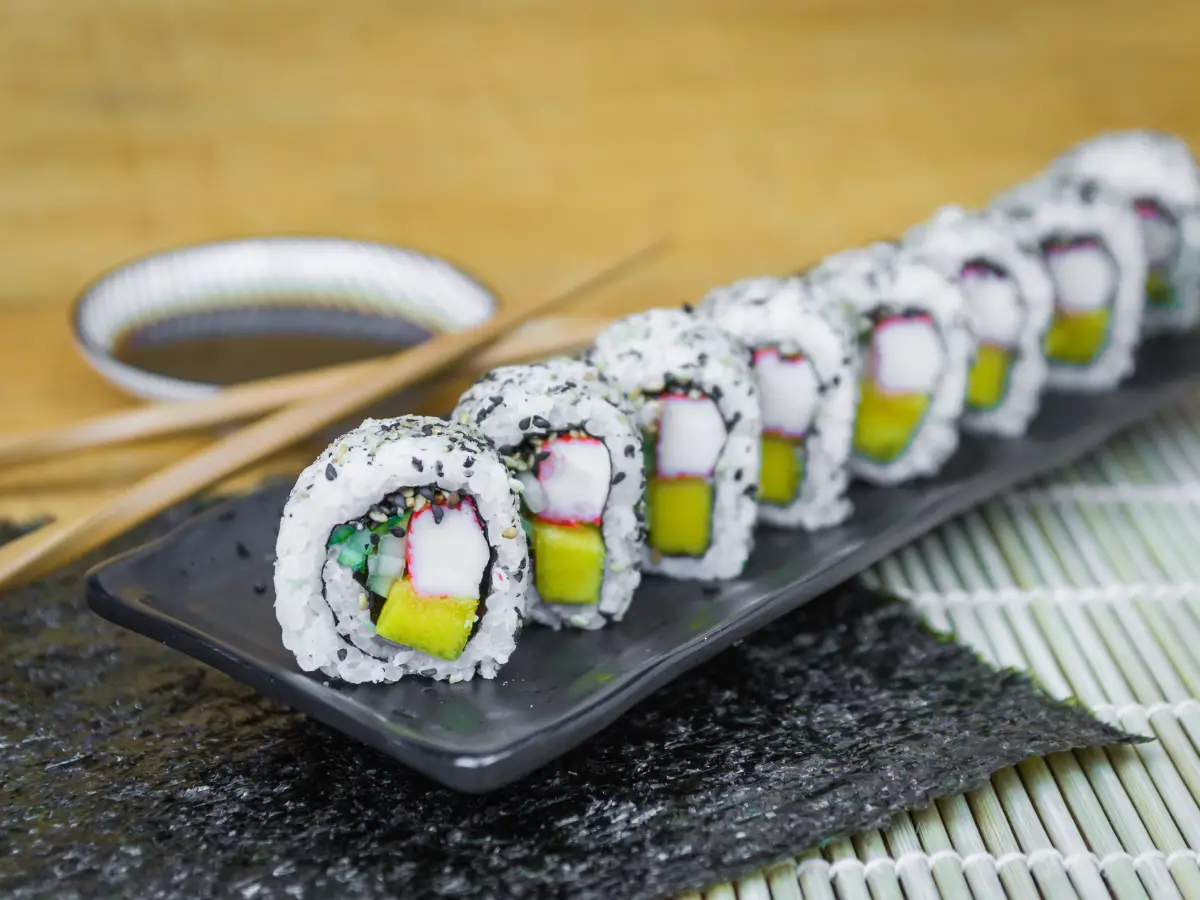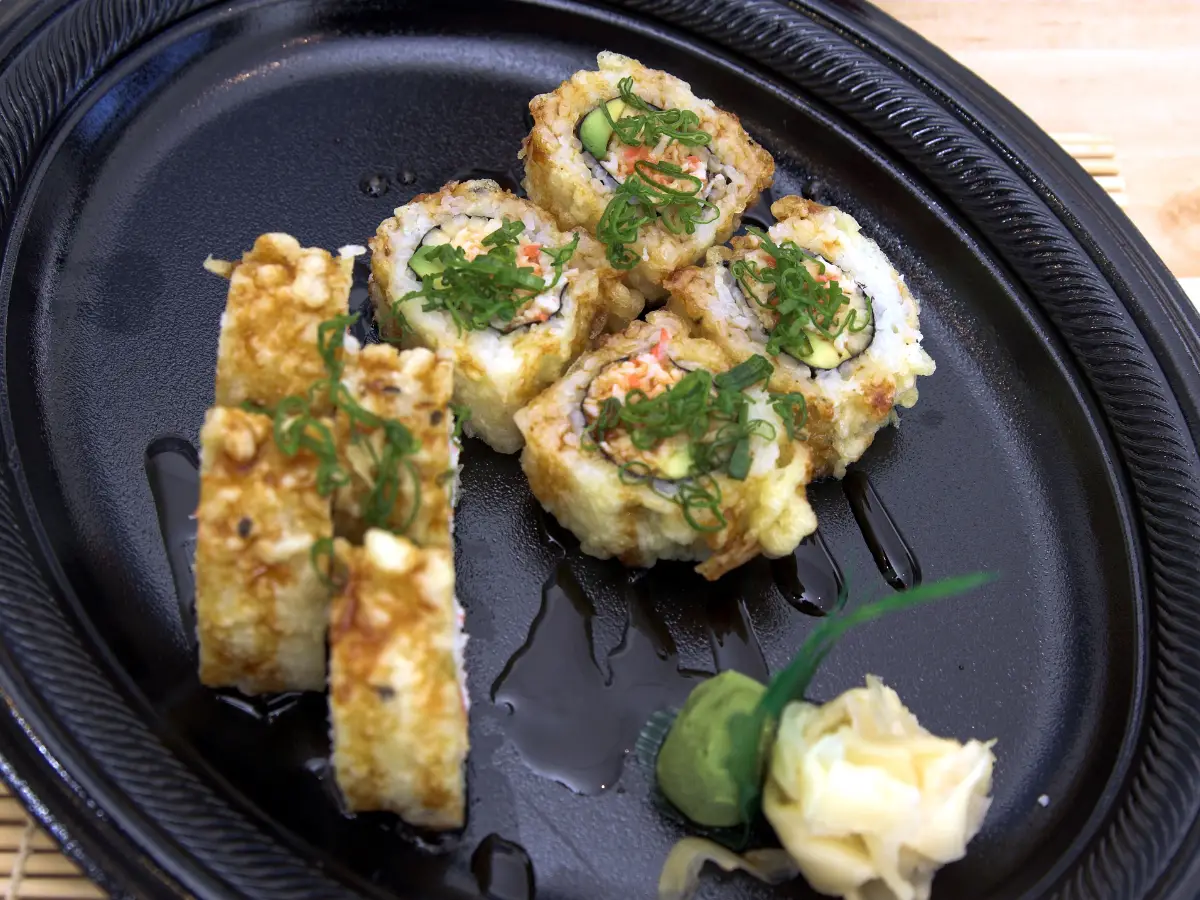California rolls are a popular type of sushi that is enjoyed by many. However, for those with celiac disease or gluten intolerance, the question arises: are California rolls gluten-free? The answer is not straightforward, as it depends on the ingredients used to make them.
While the main components of a California roll – rice, avocado, and crab meat – are naturally gluten-free, some variations of the registration may contain ingredients that are not. For example, some California rolls may use imitation crab meat, which often contains wheat or other gluten-containing ingredients.
Additionally, some sushi restaurants may use soy sauce that has gluten in their California rolls. Therefore, it is essential for those with gluten intolerance to be cautious when ordering California rolls and to ask about the ingredients used.

Understanding California Rolls
California rolls are a popular type of sushi roll that originated in the United States. They are typically made with sushi rice, nori seaweed, imitation crab meat, cucumber, and avocado. California rolls are a great option for those looking for a gluten-free sushi roll.
One of the key ingredients in California rolls is imitation crab meat. It is important to note that not all imitation crab meat is gluten-free. Some brands use wheat flour as a filler, which can contain gluten. It is important to check the ingredients on the package to ensure that the imitation crab meat is gluten-free.
Another key ingredient in California rolls is cucumber. Cucumber is a great source of vitamins and minerals and a low-calorie option for those watching their weight. It also adds a refreshing crunch to the roll.
Avocado is another common ingredient in California rolls. Avocado is a great source of healthy fats and adds a creamy texture to the roll. It is important to note that some people may be allergic to avocado, so it is important to check with your chef if you have any concerns.
Overall, California rolls are a great option for those looking for a gluten-free sushi roll. They are typically made with gluten-free ingredients and are a healthy and delicious option for sushi lovers.

Gluten and Its Sources
Gluten is a protein found in wheat, barley, and rye. It is commonly used in many foods as a thickener, stabilizer, and flavor enhancer. Gluten is also present in many processed foods, such as bread, pasta, and baked goods. For people with celiac disease or gluten intolerance, consuming gluten can lead to serious health problems.
Celiac disease is an autoimmune disorder that affects the small intestine. When people with celiac disease consume gluten, their immune system attacks the lining of the small intestine, causing damage and inflammation. Over time, this damage can lead to malnutrition, anemia, and other serious health problems.
To avoid gluten, people with celiac disease or gluten intolerance must follow a strict gluten-free diet. This means avoiding all foods that contain wheat, barley, and rye, as well as any foods that may have come into contact with gluten during processing or preparation.
Cross-contamination is a common problem for people with celiac disease or gluten intolerance. This occurs when gluten-free foods come into contact with gluten-containing foods, utensils, or surfaces. Even a small amount of gluten can trigger a reaction in people with celiac disease or gluten intolerance.
It is important to note that not all sushi is gluten-free. Many sushi rolls contain ingredients that may contain gluten, such as soy sauce and imitation crab meat. When ordering sushi, it is important to ask about the ingredients and preparation methods to ensure that the food is gluten-free.
In conclusion, gluten is a protein found in wheat, barley, and rye that can cause serious health problems for people with celiac disease or gluten intolerance. To avoid gluten, it is important to follow a strict gluten-free diet and be aware of the risk of cross-contamination. When ordering sushi, it is important to ask about the ingredients and preparation methods to ensure that the food is gluten-free.

Ingredients of California Rolls
California rolls are a popular sushi roll that typically consists of sushi rice, nori seaweed, imitation crab meat, cucumber, avocado, and sesame seeds. Some variations may also include mayonnaise or other ingredients.
The sushi rice used in California rolls is typically made with rice vinegar, sugar, and salt to give it a slightly sweet and tangy flavor. It is important to note that sushi rice is gluten-free, as it is made from short-grain rice and does not contain any wheat or gluten-containing ingredients.
Imitation crab meat, also known as surimi, is a common ingredient in California rolls. It is made from a blend of fish, usually pollock or hake, that has been ground into a paste and mixed with other ingredients such as starch, egg whites, and sugar. While imitation crab meat is generally considered gluten-free, it is important to check the label to ensure that it does not contain any wheat-based fillers or additives.
Cucumber and avocado are also commonly used in California rolls. Both of these ingredients are naturally gluten-free and provide a refreshing crunch and creamy texture to the roll.
Nori seaweed is used to wrap the sushi rice and fillings in California rolls. Nori is also gluten-free and is a good source of iodine, which is important for thyroid health.
Sesame seeds are often sprinkled on top of California rolls for added flavor and texture. While sesame seeds are naturally gluten-free, it is important to ensure that they have not come into contact with any gluten-containing ingredients during processing.
Overall, California rolls are a gluten-free option for sushi lovers, as long as you are careful to check the labels of any ingredients that may contain gluten.
Gluten in California Rolls
California rolls are a popular sushi roll that typically includes imitation crab, avocado, cucumber, and rice. However, the imitation crab used in California rolls contains gluten, making them unsuitable for individuals with celiac disease or gluten intolerance.
The imitation crab meat is made from fish and a food starch that often contains wheat, which is a source of gluten. This means that even though the other ingredients in the California roll may be gluten-free, the presence of the imitation crab meat makes the overall dish not gluten-free.
It’s important to note that cross-contamination can also be an issue when it comes to sushi. If the sushi chef uses the same knife or cutting board for gluten-containing ingredients and gluten-free ingredients, there is a risk of gluten cross-contamination. This can happen even if the California roll itself does not contain gluten.
If you have celiac disease or gluten intolerance, it’s important to communicate your dietary needs to the sushi chef. They may be able to prepare a gluten-free version of the California roll or recommend other gluten-free sushi options. It’s also a good idea to check the restaurant’s menu or website for information on their gluten-free options and cross-contamination policies.
In summary, California rolls are not gluten-free due to the presence of imitation crab meat, which contains gluten. Cross-contamination can also be a concern when it comes to sushi, so it’s important to communicate your dietary needs and ask about gluten-free options when dining out.
Gluten-Free Alternatives
For those who are on a gluten-free diet, there are a few alternatives to enjoy sushi without worrying about gluten intake. Here are some gluten-free options to consider:
- Sashimi: This is a great gluten-free option, as it is simply sliced raw fish without any added ingredients. It is important to note that some sushi restaurants may use soy sauce or other sauces that contain gluten as a dipping sauce, so it is always a good idea to ask before ordering.
- Nigiri: This is another gluten-free option that consists of a slice of raw fish on top of a small ball of rice. It is important to note that some brands of rice vinegar may contain gluten, so be sure to check the label before purchasing.
- California Roll: This is a popular sushi roll that typically includes crab meat, avocado, and cucumber wrapped in seaweed and rice. While the ingredients are typically gluten-free, it is important to ensure that the soy sauce used to make the roll is gluten-free. Some sushi restaurants may also add imitation crab meat, which may contain gluten.
- Rainbow Roll: This is a California roll with sashimi on top. As mentioned earlier, the traditional rolls are gluten-free with a few modifications. It is important to ask the restaurant to ensure that the sashimi used is gluten-free.
- Real Wasabi: Some sushi restaurants may use wasabi that contains gluten as a condiment. It is important to ask for real wasabi, which is typically gluten-free.
- Gluten-Free Soy Sauce: There are many gluten-free soy sauce options available, including Tamari and Coconut Aminos. It is important to ask the restaurant if they have a gluten-free soy sauce option available.
In conclusion, there are many gluten-free options available for sushi lovers. It is important to ask the restaurant about their ingredients and preparation methods to ensure that your meal is gluten-free.
Eating Out Safely
Eating out can be a challenge for those with gluten sensitivities. However, with a little knowledge and preparation, it is possible to enjoy a safe and delicious meal at a variety of restaurants, including Japanese restaurants that serve sushi, like California rolls.
When choosing a restaurant, consider the establishment’s reputation for accommodating gluten-free diners. Many restaurants, especially in larger cities like San Diego, San Francisco, and Los Angeles, have gluten-free menus or options. These restaurants may also have staff members who are trained in preventing cross-contamination.
It’s important to communicate your dietary needs clearly to the restaurant staff. Ask questions about how the food is prepared and make sure to mention any allergies or sensitivities. It may also be helpful to ask for recommendations on gluten-free options from the staff or other diners.
When ordering sushi, it’s important to avoid rolls that contain ingredients like tempura, soy sauce, or imitation crab meat, which may contain gluten. Stick to simple rolls that contain only rice, fish, and vegetables. Some restaurants may also offer gluten-free soy sauce or tamari as a substitute.
To further reduce the risk of cross-contamination, consider bringing your own gluten-free soy sauce or tamari and utensils. This can also be a helpful option when dining at restaurants that may not have gluten-free options or menus.
Overall, with a little preparation and communication, it is possible to enjoy a safe and delicious meal at a Japanese restaurant, even when avoiding gluten.
Making Gluten-Free California Rolls at Home
California rolls are a popular sushi roll that typically includes imitation crab, cucumber, and avocado wrapped in nori seaweed and sushi rice. However, for those with gluten sensitivities, finding gluten-free options can be a challenge. The good news is that with a few simple substitutions, you can make delicious gluten-free California rolls at home.
To start, you’ll need to make sure your ingredients are gluten-free. Here’s a breakdown of the key components:
- Rice: Sushi rice is naturally gluten-free, but be sure to check the packaging to ensure it wasn’t processed in a facility that also handles gluten-containing grains.
- Nori: Nori seaweed used for sushi rolls is typically gluten-free, but it’s always a good idea to double-check the label to be sure.
- Imitation crab: Some brands of imitation crab contain gluten, so look for a gluten-free option or substitute with cooked shrimp or crab meat.
- Cucumber and avocado: These fresh ingredients are naturally gluten-free and add a delicious crunch to the roll.
- Gluten-free soy sauce: Traditional soy sauce contains wheat and is not gluten-free, but there are many gluten-free soy sauce options available.
Once you have your gluten-free ingredients, it’s time to start rolling. Here’s a basic recipe for making gluten-free California rolls at home:
Gluten-Free California Rolls Recipe
Ingredients:
- 2 cups sushi rice
- 2 1/2 cups water
- 1/4 cup rice vinegar
- 2 tablespoons sugar
- 1 teaspoon salt
- 4 sheets nori seaweed
- 1/2 cup imitation crab or cooked shrimp
- 1/2 cucumber, sliced into thin strips
- 1 avocado, sliced
- Gluten-free soy sauce for dipping
Directions:
- Rinse the sushi rice in cold water and drain. In a medium saucepan, bring the rice and water to a boil. Reduce heat to low, cover, and simmer for 20 minutes.
- In a small saucepan, heat the rice vinegar, sugar, and salt until the sugar dissolves.
- Transfer the cooked rice to a large bowl and add the vinegar mixture. Stir to combine and let cool.
- Lay a sheet of nori on a cutting board with the shiny side down. Spread a thin layer of rice over the nori, leaving a 1-inch border at the top.
- Arrange the crab or shrimp, cucumber, and avocado in a line across the middle of the rice.
- Use the cutting board to roll the sushi tightly, using the border of rice at the top to seal the roll.
- Repeat with the remaining ingredients to make 3 more rolls.
- Slice each roll into 8 pieces and serve with gluten-free soy sauce for dipping.
Making gluten-free California rolls at home is easy and delicious. With a few simple substitutions and a little bit of practice, you’ll be rolling like a pro in no time.
Nutritional Value of Gluten-Free California Rolls
California rolls are a popular type of sushi that are typically made with imitation crab, avocado, cucumber, and rice wrapped in seaweed. For those who are gluten intolerant or have celiac disease, finding gluten-free options can be a challenge. Fortunately, gluten-free California rolls are widely available and offer a tasty and nutritious alternative.
One of the main benefits of gluten-free California rolls is that they are typically low in fat and calories. A single roll typically contains around 140-170 calories and 2-5 grams of fat. This makes them a great option for those who are watching their weight or trying to maintain a healthy diet.
In addition to being low in fat, gluten-free California rolls are also a good source of protein. A single roll typically contains around 6-8 grams of protein, which can help keep you feeling full and satisfied throughout the day.
When it comes to nutrition, gluten-free California rolls are also a good source of vitamins and minerals. For example, they are typically rich in vitamin A, vitamin C, and iron, as well as calcium and potassium.
Finally, it’s worth noting that gluten-free California rolls can be a great option for those who follow a vegetarian or vegan diet. While some California rolls may contain fish or other animal products, many are made with only plant-based ingredients, making them a tasty and nutritious option for vegans and vegetarians alike.
Overall, gluten-free California rolls offer a tasty and nutritious option for those who are gluten intolerant or have celiac disease. With their low fat and calorie content, high protein content, and rich array of vitamins and minerals, they are a great choice for anyone looking to maintain a healthy and balanced diet.
Other Gluten-Free Foods
If you have celiac disease or gluten intolerance, you may be wondering what other foods are gluten-free besides California rolls. Fortunately, there are plenty of options available that are safe to eat. Here are some examples:
Breads and Baked Goods
Many gluten-free bakeries offer a variety of bread and baked goods options that are safe to eat. You can also find gluten-free flour and baking mixes to make your own at home. Flour Craft Bakery in Marin County is a great example of a gluten-free bakery that offers delicious bread, cakes, and pastries.
Desserts
You don’t have to give up desserts just because you’re avoiding gluten. Many desserts can be made without gluten, such as cookies, cakes, brownies, and cupcakes. You can also find gluten-free options at some restaurants or bakeries. Custom cakes can be made gluten-free too.
Asian Cuisine
If you’re a fan of Asian cuisine, there are plenty of gluten-free options available. Sushi is a great choice as long as you avoid soy sauce and any rolls that contain surimi, which is made from wheat. Teriyaki sauce may also contain gluten, so be sure to ask before ordering. Real wasabi is gluten-free, but the green paste typically served with sushi often contains wheat and other ingredients.
Mexican Cuisine
Many Mexican dishes are naturally gluten-free, such as tacos, enchiladas, and guacamole. However, you should avoid flour tortillas and anything that contains wheat or flour. Corn tortillas are a safe option, as well as rice-based dishes like rice and beans.
Breakfast Foods
There are plenty of gluten-free options for breakfast, such as eggs, bacon, and gluten-free toast. You can also find gluten-free granola and cereal at most grocery stores. If you’re eating out, some restaurants may offer gluten-free pancakes or waffles.
Other Foods
Other gluten-free options include pizza with gluten-free crust, soups and salads made with gluten-free ingredients, and sandwiches made with gluten-free bread. You should always be careful of cross-contamination when eating out, and ask about ingredients or preparation methods if you’re unsure.
Overall, there are plenty of gluten-free options available if you know where to look. By being aware of what foods to avoid and what to look for, you can still enjoy a wide variety of delicious and safe foods.
Frequently Asked Questions
Are California rolls typically made with gluten-free ingredients?
California rolls are typically made with crab meat, avocado, cucumber, and sushi rice. While these ingredients are naturally gluten-free, it is important to note that some imitation crab meat may contain wheat or other gluten-containing ingredients. Additionally, some sushi restaurants may use soy sauce or other sauces that contain gluten. It is always best to check with the restaurant or sushi chef to ensure that the ingredients used in the California rolls are gluten-free.
Is imitation crab gluten-free?
Imitation crab meat is often made from a combination of fish, starch, and other ingredients. Some brands of imitation crab meat may contain wheat or other gluten-containing ingredients. It is important to check the ingredients list on the packaging to determine if the product is gluten-free.
Which sushi rolls are usually safe for those with gluten sensitivities?
Sushi rolls that are typically safe for those with gluten sensitivities include rolls made with raw fish, vegetables, and rice. Some examples include salmon rolls, tuna rolls, cucumber rolls, and avocado rolls. However, it is important to note that some sushi restaurants may use sauces or other ingredients that contain gluten, so it is always best to check with the restaurant or sushi chef to ensure that the ingredients used are gluten-free.
Does sushi rice contain gluten?
Sushi rice is made from short-grain rice that is cooked with vinegar, sugar, and salt. These ingredients are all gluten-free, so sushi rice is typically safe for those with gluten sensitivities.
Is eel sauce typically gluten-free?
Eel sauce is a sweet and savory sauce that is often used in sushi rolls. While the traditional recipe for eel sauce contains soy sauce, which is made from wheat, there are gluten-free versions available. It is important to check with the restaurant or sushi chef to determine if the eel sauce used in the sushi rolls is gluten-free.
Is sushi vinegar free of gluten?
Sushi vinegar is made from rice vinegar, sugar, and salt. These ingredients are all gluten-free, so sushi vinegar is typically safe for those with gluten sensitivities. However, it is important to note that some brands of rice vinegar may contain barley malt, which is a gluten-containing ingredient. It is always best to check the ingredients list on the packaging to ensure that the product is gluten-free.






